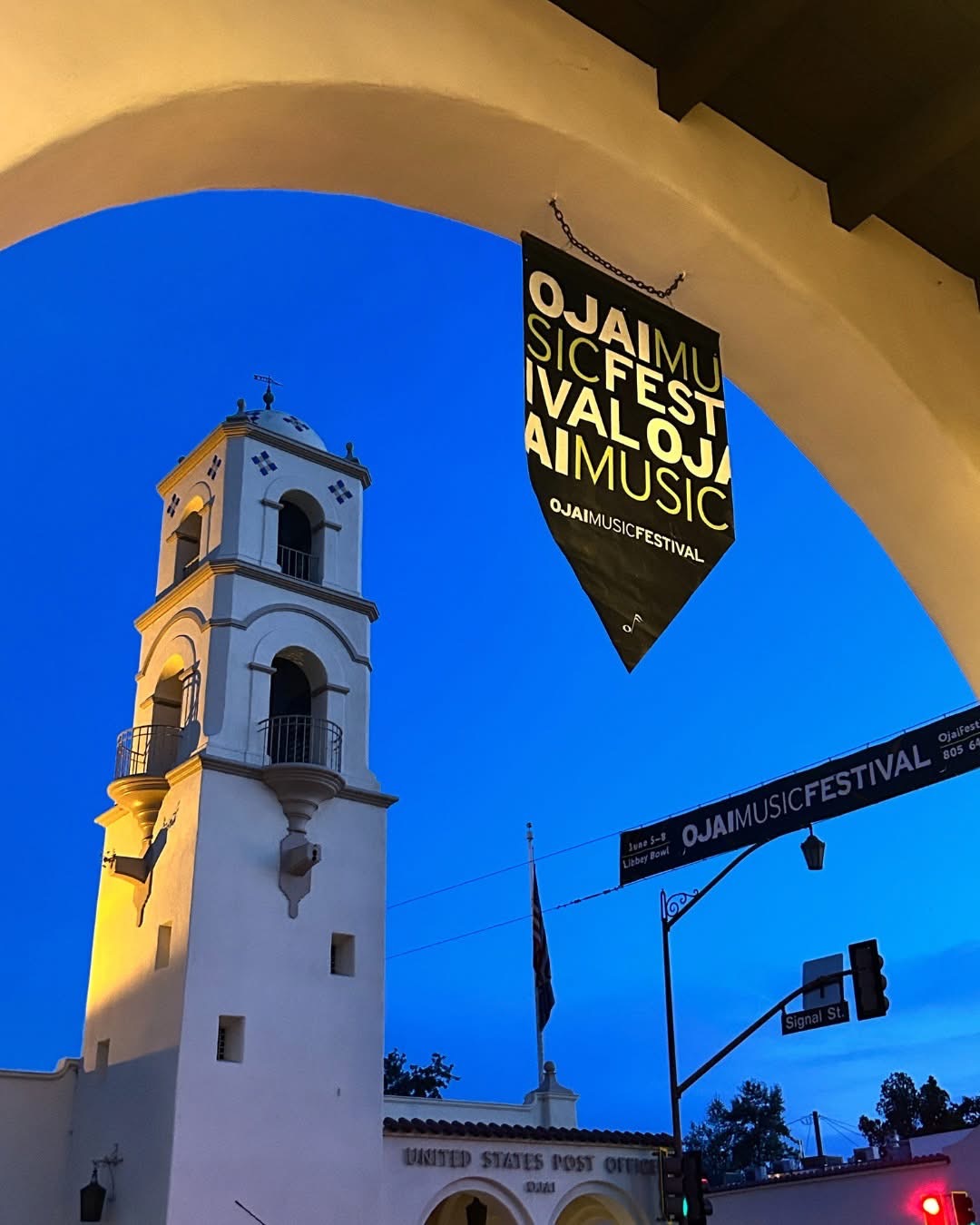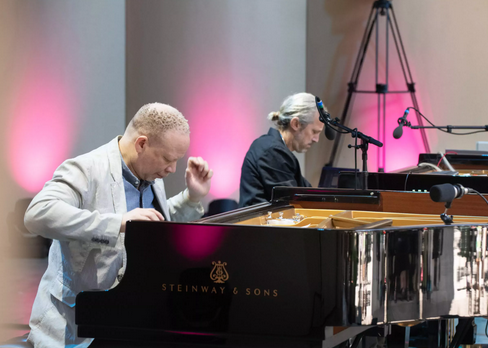Ojai Music Festival 2025 – Morning Concert, June 6

Attending the Ojai Music Festival in person is one of the great musical experiences on the West Coast. The mountains, the town, Libbey Park and great music make Ojai the place to be in early June. One of the festival’s best kept secrets, however, is that the concerts in Libbey Bowl are live-streamed over the internet. Not only that, the sound system is exceptional and the camera work excellent. If you can’t get to the Ojai Festival in person, the next best thing is to watch the streamed video. This is what I did this year and it was a real convenience.
On Friday, June 6, the first piece up in the 10:30 AM concert program was Pulsing Lifters by Terry Riley, a world premiere arrangement by Alex Peh for a keyboard trio. Pulsing Lifters is just one segment from Riley’s larger work, The Holy Liftoff, parts of which were spread across concerts during the entire festival. As the program notes by Thomas May state: “Open-ended by design, The Holy Liftoff unfolds across a series of modular scores that invite myriad realizations and improvisational approaches.” The performers for Pulsing Lifters were Alex Peh, Corey Smythe and Craig Taborn, manning two pianos, a harpsichord and separate electronic keyboards.
Pulsing Lifters opens with a soft tinkling of electronic notes that evoke an unexpected combination of spacey and organic feelings. The acoustic pianos soon joined in with some leisurely additional notes. Slow, pulsing tones were heard rising up from deep lower registers. Strong harpsichord phrases occasionally added some energy and made for an interesting contrast to the surrounding electronic sounds. It was as if the listener was drifting along in the 21st century and was suddenly yanked backwards 300 years. Terry Riley is one of the founding fathers of late 20th century minimalism, but Pulsing Lifters was clearly something different. As the piece trailed off to its quiet conclusion, one got a sense of just how far Riley has evolved. Approaching his 90th birthday, Terry Riley is still a vital and creative force.
Impressions, by Anna Thorvaldsdottir, followed. This was a solo work for harpsichord performed by Alex Peh. This is a quiet, intimate piece that completely redefines the venerable harpsichord in a way that fully engages contemporary sensibilities. The program notes explain that: “Thorvaldsdottir develops a novel timbral vocabulary using six small superballs, a superball mallet, a small metal object for sliding along the strings, and two electronic bows (E-bows), which produce continuous, bowed-like tones without percussive attack.”
Impressions opens with softly plucked tones, followed by solitary keyed low notes. As the piece proceeds, Peh alternately struck notes directly from the strings or keyed conventional harpsichord tones. Small rubber superballs were rolled across the strings, sometimes singly or several at once. A small metal rod was also used to excite several adjacent strings together. Two electronic bows were deployed on the strings and these produced a lovely arco tone. Slow and deliberate, all of this produced a continuous series of unusual sounds that were completely alien to the normal harpsichord timbre, and this served to expand the listener’s aural palette. Notes struck from keyboard were used sparingly and Alex Peh was kept mostly busy with the strings inside the harpsichord. This piece is largely comprised of a mix of engaging and experimental effects produced directly on the strings. Anna Thorvaldsdottir’s Impressions has gifted our old friend the harpsichord with a 21st century syntax for contemporary music.
Next was Cory Smythe performing Countdowns, a solo piano piece based on the music of John Coltrane. Smythe’s acoustic piano was fitted with a detuning mechanism which allowed the playing of quarter tones from two separate midi keyboards. The result is a seamless blend of conventional and present day sounds.
Countdowns begins with deep chords. Strumming on the piano strings produced dark clusters of tones and soon electronic sounds are heard underneath. There is a heavy feeling to all of this, broken occasionally by some light phrases in the higher registers. Smythe stays active attending to the keyboards, strings and electronics, all more or less simultaneously. The phrases in this mix are occasionally somewhat faster, but seem to come and go without any larger structure. Some of the rapid phrases seem to overlap, reminiscent of Coltrane’s ‘sheets of sound’ style. There was a dazzling flurry of notes at the finish. This piece was inspired by Giant Steps, but there are only flashes of the hard bebop style that we associate with Coltrane. Countdowns seems to be trying to connect directly with Coltrane’s deeper spirituality using 21st century musical syntax, a worthy – if daunting – effort.
The final work on the program was Duo Improvisation for Ojai, performed by Craig Taborn and Corey Smythe. This allowed the two performers to stretch their musical legs in an extended improvisational format. Corey Smythe was again stationed at his formidable array of piano and electronics with Craig Taborn at a second acoustic piano. As Thomas May explains in his Ojai program notes: “Taborn describes their approach as an ‘information-rich, improvisational process’ shaped by structural elements proposed in advance.”

Duo begins with low notes plucked directly from piano strings. Soon, some higher electronics and piano notes are heard, all at a deliberate pace. There is a very experimental feel to this with a variety of tones and timbres that are combined by extended techniques. Soon, a driving pulse is heard underneath with a series of complex phrases from each keyboard. These interleave between each other, occasionally producing a rapid blizzard of notes. At other times the tempo, dynamics and rhythms are more restrained and the feeling is more ominous. Towards the finish, an active and complex texture is heard, with individual notes pouring out of each piano. The dynamics and tempo quickly moderate and the piece quietly drifts along, ending on a deep piano note in the low register. Duo Improvisation for Ojai, is an impressive piece performed by two outstanding talents and was a lively conclusion to a concert filled mostly with introspective music.
The June 6 Friday Morning concert was a polished and innovative start for the day, and included lots of unusual keyboard techniques that were both memorable and impressive.
Photo Credits: Timothy Teague